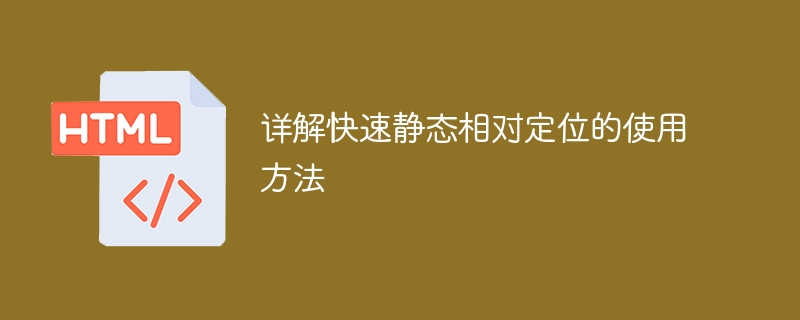

Fast static relative positioning is a very important positioning method in web development. It allows an element to be slightly adjusted relative to its normal position while still maintaining its position in the document flow. In this article, I will introduce in detail the use of fast static relative positioning, as well as some common application scenarios.
First of all, we need to understand the basic concept of fast static relative positioning. In CSS, there are four ways to position elements: static positioning, relative positioning, absolute positioning and fixed positioning. Static positioning is the default positioning method, and the position of the element is determined by the document flow. Relative and absolute positioning allow an element to be taken out of the document flow and positioned relative to its parent element or page. Fixed positioning is positioned relative to the browser window.
Fast static relative positioning is a special relative positioning method, which is achieved by using the CSS property position: relative. Compared with other positioning methods, fast static relative positioning has the following characteristics:
Using fast static relative positioning is very simple. Just set the position attribute of the element to relative in the CSS style. The following is an example:
.box {
position: relative;
top: 10px;
left: 20px;
}The above code performs fast static relative positioning of an element with a class name of .box, moving it 10 pixels down and 20 pixels to the right.
In addition to the top and left attributes, we can also use the bottom and right attributes to adjust the position of the element. The values of these properties can be pixels, percentages, or auto. At the same time, we can also use the margin attribute for fine-tuning.
Fast static relative positioning has many practical application scenarios in web development. Here are a few common application examples:
In summary, fast static relative positioning is a very practical web development technique. It allows an element to be slightly adjusted relative to its normal position while still maintaining its position in the document flow. We can easily use fast static relative positioning by simply setting the element's position property to relative. Whether you're creating floating effects, fixing layout issues, or fine-tuning layouts, you can do it all with fast static relative positioning. More importantly, mastering the use of fast static relative positioning can allow us to position elements more flexibly in web development.
The above is the detailed content of Quickly master the techniques and methods of static relative positioning. For more information, please follow other related articles on the PHP Chinese website!